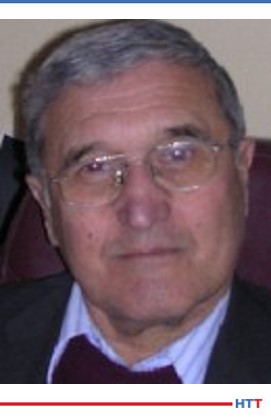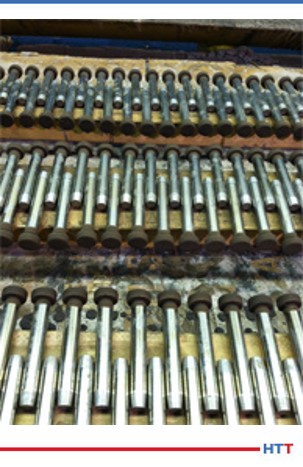 Heat Treat Radio host, Doug Glenn, discusses how one company saved over $700.00 in hard grinding costs PER GEAR on an 18-inch bevel gear. Joe Powell of Integrated Heat Treating Solutions tells how they did it. Listen to find out how Joe helped this company upgrade their heat treating and bring it into the 21st century.
Heat Treat Radio host, Doug Glenn, discusses how one company saved over $700.00 in hard grinding costs PER GEAR on an 18-inch bevel gear. Joe Powell of Integrated Heat Treating Solutions tells how they did it. Listen to find out how Joe helped this company upgrade their heat treating and bring it into the 21st century.
Below, you can either listen to the podcast by clicking on the audio play button, or you can read an edited version of the transcript.
Click the play button below to listen.
The following transcript has been edited for your reading enjoyment.
Doug Glenn (DG): This episode is the second in four conversations with Joe Powell on “quench to fit” technologies. Joe is from Akron Steel Treating and Integrated Heat Treating Solutions. We wanted to review a bit of what we talked about last time in our first podcast. Probably the best way to summarize it to say that we’re trying to get heat treaters to think about heat treating differently: not heat treating in the 20th century or even the 19th century, but in the 21st century. What do you say to that?
Joe Powell (JP): Yes, we’re trying to integrate heat treating solutions into the part making process and take advantage of all of the sensor technologies, all of the manufacturing technologies, all of the other advantages that happened in metallurgy in the last half of the 20th century in terms of atmosphere control, temperature control, vacuum furnaces, and integrate them with the part design.

DG: You and I were talking about a statement that was said by one of our mutual friends, and the statement was this: “Every metallurgist knows the faster the quench cooling rate, the higher the probability of cracking a hot part.” What do you say to that?
JP: It was professor Jack Wallace who was the head of the metallurgy department in 1997. When he heard about intensive water quenching, he said it would absolutely not work. He was so sure of it, he basically blurted it out, “It will never work! The parts will blow up in the quench!” If anybody knows Jack, they know that’s exactly how he would say it! The other people in the conference room, just kind of looked at each other: Wayne Samuelson from Shore Metal Treating, myself representing Akron Steel Treating, and John Vanas representing Euclid Heat Treating.
The other two heat treaters in the room heard Jack say this and thought, “Well, you’ve got to be right, majority rules,” but I said to myself, “Well I don’t know who Jack Wallace is, (because I didn’t at the time), but I do know Michael Aernoff and he’s introducing this water quenching technology that was discovered by Dr. Nikolai Kobasko back in the former Soviet Union, and I’m willing to give it a try. All he wanted me to do is heat up some parts (made by Timken Bearing) and quench them in a water bath. They were made out of 52/100. I knew 52/100 blows up when you look at it sideways and when you quench it because it’s a deep hardening steel. But if Michael says you can do it, the worst that can happen is it’s going to blow up, in which case everybody will be wearing a face-shield when it goes in the water. The best thing that could happen is that it doesn’t blow up, and we’ll learn something.
About six months later, this prototype tank shows up at Akron Steel Treating with some tapered bearing rings about 10 inches in diameter. We basically said to ourselves, “Let’s heat them up and see what happens.” They came out of the water about 20 seconds after going in; they flash dried as the core heat had just tempered the martensite that we had just formed on the shell; and they didn’t crack. Then, we did a whole bunch more of them. Jack Wallace was present for that demonstration and he just looked at it and said, “We gotta figure out how this works.” That was in 1998, I believe.

DG: For the reader’s benefit, let’s give them the birds-eye view of what happened.
Last time, you had said that if you can quench a part fast enough in all areas so that you get below the martensite start temperature, then that actually forms what you could imagine in your mind to be a dye shell. It just holds the part in place.
JP: Yes, it’s a hardened shell over the still hot and plastic core of the part. So, whatever the geometry is, that is what you have locked it in.
DG: And that is, in fact, the key, right? Just reviewing what we talked about last time: The key is you lock the geometry of the part in, regardless of what the shapes are, regardless of whether you have hidden holes, whether you have grooves and everything; you lock it in and then all you have to do is keep that shell at below the martensitic start temperature until the core “cools,” which can be calculated. Then, you’re done.
JP: That’s part of the science behind it, yes. At the end of the day, the trick is to have the equipment to be able to do that. The equipment in 1998 was available to do batch quenching. In fact, in 1999, Akron Steel Treating spent a good deal of money to build a 6,000 gallon quench tank that essentially we are still using today at Akron Steel Treating to do intensive water quenching.
DG: Just to be clear, also from our last episode, it isn’t always that it has to be an intensive quench. It doesn’t have to be instantaneous.
JP: Right, so it also works at the other end of the continuum. If you can build a uniformly hardened shell on a part that is made of high alloy air hardening steels, you can actually develop in a gas quench a very uniform, very predictable size change in that shell. That allows you to predict how the part is going to move so that you can machine it before heat treatment so that it literally morphs into the hardened shape that you want.
For instance, take a very thin, complex bearing ring that has a very thin wall that’s made out of a Pyrowear 53 material, which would basically harden up in air — this is part of the DANTE Solutions patent that we discussed last time. [See original DANTE Solutions HTR] The gas quenching process first creates a shell at the thin section, then stalls out the temperature to keep the temperature hot in the gases, which are flowing across the part during the quench, thus allowing the thick sections to catch up. When the thick sections catch up, and once the thin and thick sections have thermally shrunk a certain amount, then you go to the next plateau in temperature cooling. Here, the gases are introduced to the part surface to bring the thin section down first, and then the thick section. You would continue to do that until you get to the martensite start temperature.
[blocktext align=”left”]“If you go too fast, it will crack the part and it will blow the shell off, and that’s what gives water quenching such a bad name; because the core swells up and blows the corner off the part.” – Joe Powell[/blocktext]At the martensite start temperature, you then do the same thing: let the part stabilize at that temperature in the thin and thick sections, and now you have a shell that’s locked in the part. As the part is cooling down into the core, the thin and thick sections of that core are now going to start the transformation to martensite at about the same time. That means that you have a very predictable size change from the thermal shrinkage, and then the following phase change expansion as the austenite kicks over to martensite. That phase change expansion is the thing that you really don’t think about, but that’s what has to be controlled in order not to blow the shell off. If you go too fast, it will crack the part and it will blow the shell off, and that’s what gives water quenching such a bad name because the core swells up and blows the corner off the part.
DG: You said that there is a need for equipment that is able to do what you’re talking about. In the last episode, you said that there are a lot of really good furnace companies out there and that they are “furnace companies” but what they really ought to be doing is focusing on becoming “quenching companies.” Can you expound on that just a bit?
JP: They obviously need to focus on the heating part and that needs to be uniform, but they’ve given absolutely no focus to the quenching part and how uniform it is over time, and between part to part in a load, and how it affects the compressive stresses. The quenching process is more important, in my mind, than the heating process. And yet, there are no specifications on quench zone uniformity. We have to run surveys at Akron Steel Treating all the time on our heating zones. But when you open the door on an integral quench furnace and go into a quench tank, how uniform is that quench? We don’t know. We hope it’s uniform.
DG: We need a “TQS,” a temperature quench survey.
JP: Yes, exactly! Well, it’s really a uniformity survey for the quench cooling rate.
DG: A “QUS,” a quench uniformity survey, how about that?
JP: Doug, we don’t need another acronym– People will go crazy!
DG: I’d like to ask you a few questions about this one example of an 18-inch bevel gear that Integrated Heat Treat Solutions worked on with a company that may remain nameless, unless you would like to name them.
JP: They will remain nameless, but I can tell you that it’s an Ohio company that makes rolls for steel mills. For years, they refurbished and made rolls and “shavs” for steel mills and bought all their gears from outside. They got gears from various sources, and some of the gears that they got over the years were these large roll drives for steel mills in which some of the teeth would fall off. It was very unpredictable. They had the right hardness on the surface, they appeared to be made out of a high quality 8620 carburizing steel, but when cut apart, a very fine gear metallurgist indicated that the teeth, which were a pretty good size, had carburization of 60,000th effective case steps on the tip, but at the root of the teeth, they only had 15,000th effective case steps. This indicated to us that there was an ineffective oil quench after the carburization process. The carbon is there, but it just didn’t quench out to give you the 50 Rockwell effective case steps at the root of the teeth. When we thought about it, we asked, “How do you run bevel gears?” You stack them on top of each other in the furnace, you heat them up, you carburize them, and you quench them. Well, when they’re stacked on top of each other, the oil cannot circulate and quench the teeth either effectively or uniformly, especially at the root where the heat from the hub is constantly coming out. Additionally, you have a long period of basically gas quenching as the oil boils in all of those big teeth at the root.

So the first thing we said was, “Well, if we do them, we’re not going to stack them up like that.” The second thing we said was, “Why don’t you let us try our water quenching process in our 6,000 gallon tank?” They said they had nothing to lose, and they gave us some gears. Believe it or not, with no gear cutting equipment, they were making the gears on a 5-axis CNC machine. Then they cut the gears out. These gears are not high quantity gears; these are for steel mills and you use hundreds per year, not thousands or millions. And each gear is a pretty good buck, so they can afford to make it on a 5-axis CNC machine. What they did was they cut the gear out by measuring a gear that had a broken tooth, using the metrology that this company also had, (and they have some really cool laser based metrology for measuring parts), and they created a cloud map.
That cloud map was then used to program their CNC machine. They then sent us these rough-cut gears, and we heat treated them. We carburized them for like 20 hours and I think we left around 60,000th of grind stock on them. When they got the gears back, they said, “These are pretty doggone uniform. Do you think we could tighten up and not leave so much grind stock so we could save some money on our grinding?” And I said, “Yes! Let’s try it.” So, on the next part, we left less grind stock. By the sixth sample gear, we had it down to the point where the gear literally was cut in the 5-axis CNC machine in such a way that the gear teeth came out, but they didn’t need any grinding. They were as straight across the top and they quenched to fit.
I asked, “How much does that save you per gear?” They estimated about $750/gear in grinding costs that they were avoiding. “Well that sounds pretty good,” I said, and they said, “Yes, we think so too.” So, we’ve been doing them ever since. We do them in lots of 12 at a time on racks in our radiant tube batch furnace, (it’s an atmosphere furnace), across the aisle from our 6,000-gallon batch quench tank.
[Image.furnace grate] The other thing that we learned from this experience was that the distortion was very, very predictable as long as we didn’t set the hub on the furnace grate. The furnace grate has two areas where the rollers in the integral quench furnace ride on the furnace grate, and those 4-inch-wide tracks essentially block the quenching water from hitting the bottom of the hub. In those areas, their cloud map showed that there was a distinctly different kind of an ovality to the hub on the ones that were quenched on the grate. Now that could be ground out; it wasn’t that big of an ovality. But, it was a non-uniformity that could be avoided simply by raising up the part on the grid allowing the water to reconnect when it rose from the bottom in the batch quench tank to flow around the hub of the part.
The second thing that we learned was that the parts have higher residual compressive surface stresses on the teeth. Our new gears were wearing down case carburized and oil quenched gears that were on the motors driving the steel mill rolls, yet those case carburized gears are the exact same hardness. The difference was that they don’t have as high of compressive residual surface stresses in the case as we developed in our carburizing and intensive water quenching process.
The third thing we learned—and we knew this a long time ago—is that we could cut the carburizing cycle time by about 36%, versus using oil quenching, and still get the same effective case step because we don’t need to drive in as much carbon into the gradient to develop the 50 Rockwell minimum hardness for the effective case step.
[blockquote author=”Joe Powell” style=”1″]“It’s a win-win-win. The customer is happy, we’re happy and it works. This demonstrates that you can indeed quench very, very intensively. We’re talking about 400-600 degrees Centigrade/second of quenching.”[/blockquote]It’s a win-win-win. The customer is happy, we’re happy and it works. This demonstrates that you can indeed quench very, very intensively. We’re talking about 400-600 degrees Centigrade/second of quenching. You can set the shell and once that shell is set, the part predictably changes to a martensitic case-hardened structure on the outside and a relatively ductile core from the 8620 material, and you get a good gear that is very, very consistent that doesn’t need to be ground after heat treat.
DG: The material that they initially came in with was 8620, and you didn’t change the material; you just changed the processing cycle, which was shortened by about 10 hours (36%), and you were able to get the same hardness. But you were also able to get higher compressive residual surface stresses which actually made that bevel gear all the more effective and more robust. And you saved $750/per gear in grinding costs.
JP: Right, and this is from a company that never made a gear before. They had a 5-axis CNC machine and a bunch of smart guys and this new metrology that they have, (which gives them millions of points of measurement on that gear). And at the end of the day, all I can say is it is pretty amazing, because now they can adjust the green size by comparing the post-heat treat cloud map to the pre-heat treat cloud map and constantly whittle away at the amount of grinding stock that they need with each load until they get it to the point where it doesn’t need to be ground.
DG: So all they do is quench it and fit it, thus your statement, “quench to fit.”
JP: Yes, quench to fit. We obviously temper after quenching, but that’s it. They do clean up the hub, and they do clean up the ID of the hub just to make sure everything is square, so that the gear runs true. But the teeth are not ground in this application.
DG: You mentioned earlier that the initial gears that came in had 60,000th effective case step at the top and 15,000 at the root. Did you do tests on yours, and how did it turn out?
JP: They are super consistent. They have the 60,000th required case all the way around.
DG: This is one excellent example of what you’re talking about with “quench to fit.” I know that you’ve had other applications where you’ve done the same thing, so what part do you want to talk about next time?
JP: We’ll talk about fracking pump valve seats that can be made for about $150, which competes against the typical $800 sintered carbide valve seat.
DG: Stay tuned for that. We’ll get that one on our next podcast.
JP: Alright, thanks so much, Doug.
Reach out to Joe Powell at www.integratedheattreattingsolutions.com or www.akronsteelheattreating.com.
To find other Heat Treat Radio episodes, go to www.heattreattoday.com/radio and look in the list of Heat Treat Radio episodes listed.






